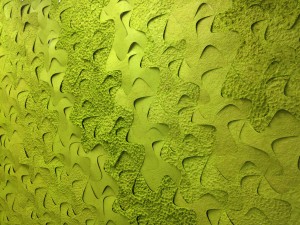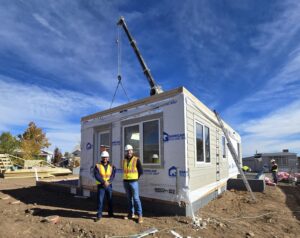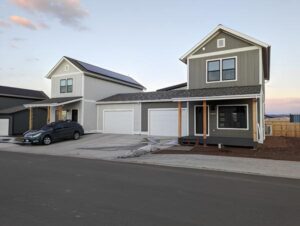
Recently, the Boston Society of Architects (BSA) agreed to host “Bigger than a Breadbox, Smaller than a Building“, an exhibition of art designed to “examine the appropriation of installation in contemporary architectural practice.” A cornerstone of the exhibit will be an installation chosen from a pool of international applicants by a jury of artistic and architectural professionals from across the United States.

The submitted installation proposals were required not only to activate the central gallery space at the BSA, but also carry through a design theme from a previous installation by the same artist. After much deliberation, the jury chose “The Pulp Canopy”, an installation designed by Katie Donahue, Mason Limke, and Yandy Cheng. The installation is a continuation of their “PulpWall” project, which won an AIA Colorado Young Architects Award and was selected for exhibition at the AIA Emerging Professionals Exhibition in Washington, D.C. The original installation was created from tiling modules of recycled paper, cut from sheets of specific textures, and the placed by hand to create the design at left.
The Pulp Canopy, as an outgrowth of their previous work, was created from recycled paper modules that were dyed and screened at the University of Colorado. These modules were then suspended in a mesh of welded wire fabric which was slung in a catenary curve between opposite sides of the gallery space.
The team’s original proposal stated:
Created with 800 rolls of toilet paper collected from airports that discard hundreds of pounds of partial rolls each week, [The Pulp Canopy] investigates the use of paper pulp in architectural application. It incorporates more than 2,800 triangular objects strung from one end of the Atlantic Wharf lobby to the other. The multiple strands of panels, organized into the shape of a canopy, create a dynamic piece that explore texture, color, light and movement. Donahue, Limke, and Cheng’s work aims to entice passersby to consider the diverse ways something as mundane as paper can be given new life and become spatial and interactive.
An installation of this type requires not only artistic and architectural design, but structural considerations as well. The team worked closely with a structural engineer during the early proposal phase to ensure that the artwork would support itself. However, shortly before construction began, the team was informed that they needed an additional structural review prior to installation. As the original structural engineer was not available, Donahue turned to EVstudio.
Using the details from the original proposal, modified by the materials the team had procured on-site, EVstudio was able to quickly satisfy the owner that the art installation was neither a threat to the structural integrity of the building, nor a danger to the public. As the installation was to proceed over the weekend, we also arranged for a staff engineer to be available for any last-minute modifications that the team needed to make.
While there were some minor hiccups — one of the vendors shipped heavier-duty material than was originally specified — the team completed the installation on schedule for the opening. If you happen to be in Boston, the exhibit runs through October 4, 2015.










1 thought on “EVstudio Collaborates on Art Installation”
You can read further commentary by the artist — including the logistics of casting the paper elements — at http://aiacoloradoepblog.com/2015/09/25/live-from-new-york-city-katie-donahue-talks-about-her-recent-award-winning-installation-the-pulp-canopy-and-where-you-can-find-800-rolls-of-toilet-paper/
The exhibit is closing this weekend, but as of this writing, two museums have expressed interest in hosting the installation. We’ll keep you posted!
Comments are closed.